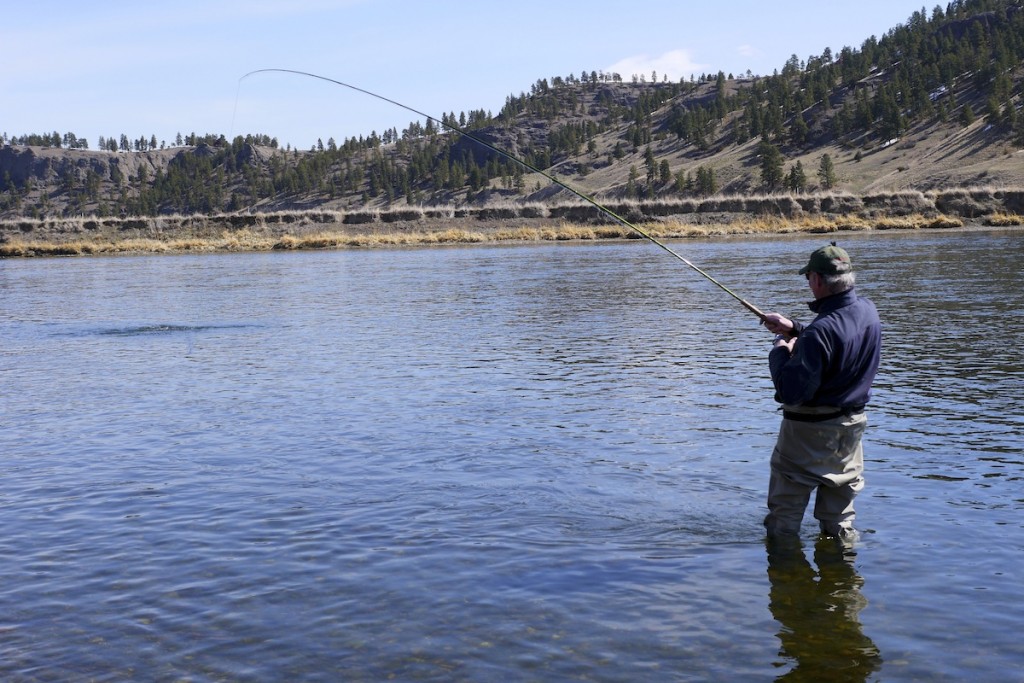Over the last few winters, I’ve spent more time fly fishing the Mo’ with a two handed rod than with a single hander. This is especially true when it comes to streamer fishing. In fact the inconsistent and often slow winter streamer fishing is one of the reason I first played the waters around Craig with a two-hander.
Now, most of the crew at Headhunters are competent two-handed casters and anglers, and all enjoy it. That’s part of the reason that we spend much of the winter driving our cars up and down the river with long rods on the roof. And we’re not the only ones. In the 20teens, it’s not unusual to see more folks bouncing around Craig with rods over 11 feet than under. It’s very hip.
But from a practical fly fishing standpoint, it’s also effective. In fact, I believe it’s more effective to fish a streamer on a two-hander while wade fishing, than it is to fish a streamer on the strip from a boat.
This fact was brought to my attention last weekend. I spent the day hucking streamers with a couple of extremely competent fly fisherman, both of whom are streamer junkies. Our primary goal was to get out on the water and enjoy some beautiful mid-winter weather (temps around 50). This we did. Our secondary purpose was to hammer a bunch of big fish on stripped streamers. This we did not.
Now, we didn’t get skunked. In fact, we caught a fair number of good fish. But only when concentrating in dead water using slow retrieves. We definitely had some long stretches with little action
As we were fishing, it occurred to me that we would likely catch more fish wade fishing with the same flies using a two-hander (or a single hander), fishing down and across “Steelhead” style. But why?
Probably has a lot to do with moving the fly slowly, through the slow water that fish tend to congregate in this time of year (a subject I touched on last week in a post about nymphing).
Think about it. When you’re swinging in low and slow winter currents, that fly is in front of the fish for a much longer period. They can see it, and don’t have to move to follow it. It’s conceivable that a fish could see your fly for 30 seconds or more in certain runs.
When you’re stripping sideways to the current from the boat, the trout only see it for a moment, and must move if they are interested in taking a further look. Fish holding in calm water may do this, but it is unlikely that fish holding in current will leave a holding spot in our current arctic conditions.
Simple as that. Cold water. Slow presentation. One more reason to get out on the river with your spey rod, switch rod or two-hander.


9 Comments.
Hey John-
Thanks for putting me on the blog!!! Using my spey rod here in New Hampshire for monster browns! You guys out there, John Arnold is the one to get a lesson from!
[…] Why Spey Rods are More Effective in the Winter. […]
Agreed John these fish this time of year are either in the yes or no mood. I truly believe
if it’s streamer fishing that your concentrating on your best bet is to leave the boat home
or use it to go from productive run to productive run. I don’t think it hurts to have a guy
chucking along the way but don’t waste time on unproductive water. Those long slow
tailouts that dump of into deeper water can be money this time of year. I also agree
the down and across is the best way to aproach those runs. It’s been wierd for me these
past couple weeks, I’ll go through a run with a fly that has been working great for me
to be completely snubbed. I’ll fish all the way through the run from top to bottom with
not a grab. I change flies go back up and through and it;s like every fish in the run is
on it. Granted time of day is huge, and that 2:00 to 3:30- I’ll be where I think there is a
big one guaranteed. Those big fish don’t let down there guard very often, but this time
of year they will eat if its in there face.
Hope all you guys are doing well, fishing has been good up here, give me a shout, I would
love to have you come up and spend a day North. Kirkpatrick
Good insight John!
I would add that hanging a fly within podded-up fish that are already agitated by the pack
is a great way to promote that aggressive strike. I think that is why bright, gaudy flies work
So well on the Mo.
Thanks for the blog post…good stuff. What rod (weight/length) have you been using on the Mo?
We use fast action 6 and 7 weights most of the time, both switch and two-handed rods with Scandi lines.
what length do you like most on the Mo?
I use both switch (11′-11’9″) and two handers at 12’6″. I think most prefer the switch (Sage Method, Echo 3, Orvis Access), but many seem to buy the 12’6″ rods, with the thought that they can cast it further or that it will be more versatile than a switch if they go Steelhead fishing, etc. One thing is for sure, the longer rods are better if you plan on using sink tips. If not (and I never do for trout on the Missouri), then the switch rods are more powerful, better in the wind and funner to fight fish on. Two fantastic rods that we have in demo this year are the Thomas & Thoams XF series 11’7″ #6/7 and the 12’6″ #7. Ninch and I used these on the Grande Ronde in November and they are outstanding. The 11’7″ is not a “switch” rod, it is designed as a two-hander. T&T also makes a switch in that size.
Thanks John – I really appreciate the info. Excited to keep learning and getting in on this fun. Thank you again!